Using the Collaborative Learning framework to improve IAN’s report card development process and outcome
Vanessa Vargas-Nguyen ·Last November 5, 2017, Suzi Spitzer and I attended a Collaborative Learning workshop during the 24th Coastal Estuarine Research Federation Conference in Providence, RI. The workshop was facilitated by Dr. Christine Baumann Feurt of the Wells National Estuarine Research Reserve Coastal Training Program. Attending this workshop was one of the highlights of my CERF experience. More than anything, it became clear to me that the Integration and Application Network's (IAN) science communication and stakeholder engagement process takes the form of collaborative learning, and as such, can be improved by following this framework. I was also excited because this workshop supported most of the ideas that I had laid out in my comprehensive exams and dissertation proposal in improving IAN’s report card process. Furthermore, it gave me ideas on how to improve my research and gave me additional conceptual framework and theoretical grounding to work on.
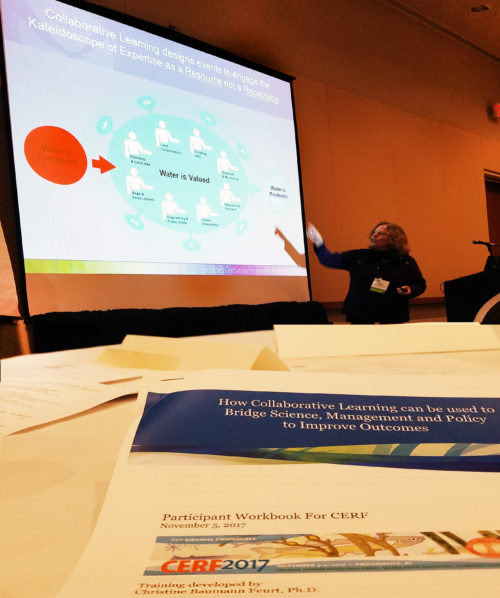
Collaborative learning is “a framework and set of techniques intended for multiparty decision situations… A means of designing and implementing a series of events to promote: creative thought, constructive debate and the effective implementation of proposals that the stakeholders generate.”1 It can be used to bridge science, management and policy to improve outcomes. I particularly like how Dr. Feurt frequently emphasized that the goal is to improve the situation and not to find the solution. This makes Collaborative Learning a more fluid process that requires engaging people with diverse and conflicting viewpoints. It brings emphasis to the knowledge that each stakeholder possesses to collaboratively develop a vision of desired future outcomes that integrates ecological, social, economic, cultural and organizational perspectives. Similarly, report cards are being used to bring together decision-makers, managers, scientists, stakeholders, and citizens to develop a shared vision, assess present conditions and come up with adaptive management plans for a particular ecosystem.
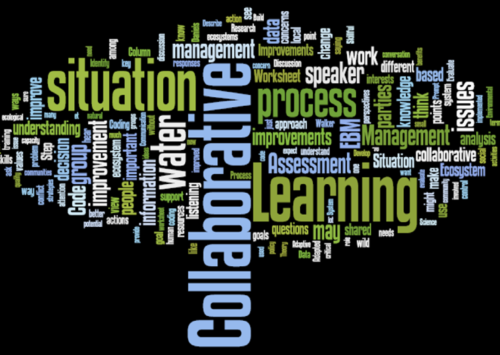
Below are some key points from the workshop that can be applied to and help improve IAN and the report card process.
1. The preparation time prior to the collaborative learning event (i.e. report card workshop) is the most important. According to Dr. Feurt, for a collaborative learning event to be successful, the team should allocate 2 people working for 2 weeks to do the initial assessment and preparation which include understanding the nature of the problem and identifying potential stakeholders. For our report card development process, the collaborative learning event is the workshop for developing the report card. As I have emphasized in my comprehensive exams last year, IAN’s 5-step report card process can be improved by following a System’s thinking approach in problem solving. Foremost to this is for the project team to have at least a basic understanding of the system and the nature of problem prior to the workshop. Stakeholder participation is also critical in the report card process; thus, careful stakeholder selection should be done right from the start of the project and continuously throughout the process.
2. Social science tools can be used to overcome barriers of learning. The common barriers that collaborative learning can helped bridge are perceptual, institutional and disciplinary barriers. Social science tools that can be used to overcome these barriers are stakeholder analysis, institutional analysis, and cultural analysis. For my dissertation, I am using stakeholder analysis and cultural analysis to develop a framework for an improved report card development process. In a previous blog, I have already discussed one of this tool, Social Network Analysis (a form of stakeholder analysis). The other method is the use of mental models which are "simplified representation of the world used by people to infer what is known and unknown and solve problems." Knowing the existing mental models of the different stakeholder in our report card process can facilitate better communication. Understanding both social networks and mental models can lead to effective collaboration that can lead to positive action, and not just the usual and mostly symbolic call to action.
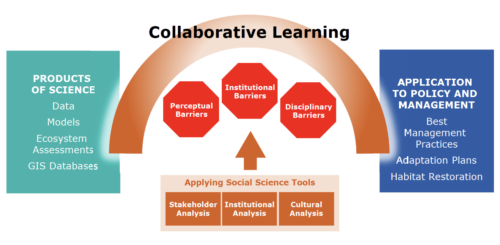
3. High impact communication of the value of ecosystem services can motivate people to act. One of things that we are grappling with in IAN is on how we can make our report cards go beyond just being a communication tool, but also as a catalyst for behavior change. In the Collaborative Learning framework, this is achieved and can be evaluated by moving decision makers from awareness to collaborative action, mostly on issues that relates to ecosystem services. In the same manner, our report cards should highlight the kind of ecosystem services that users benefit most from their environment. Why the ecosystem is important to the users, how it affects their daily lives, and what roles they play in the process are some of the information that should be highlighted.
4. Situation Mapping facilitates discussion and enables the group to “get on the same page”. The purpose of situation mapping is to build a shared understanding of the situation and the diversity of ways people see the issue, what they value and perceive as threats and barriers. If this sounds familiar to any of you knowledgeable of IAN’s values and threats SNAP exercise, you are not mistaken. The main difference with Dr. Feurt's situation mapping exercise and IAN’s SNAP exercise, aside from the delivery, is the inclusion of a third question. Participants are divided in small groups and each person is asked to answer the following questions in colored sticky notes: 1 - what is valued by stakeholders in your situation? (green sticky); 2 - What are threats impacting what people care about? (red); and 3 - How does your work contribute to protecting what people care about? (blue). These notes are then placed in a butcher paper and arranged in such a way that the values are in the middle, the solutions surrounding the values, then the threats in the periphery. For me, this exercise makes the issues more personal because it helps the participants see that they are part of the system. Situation mapping is one way to reveal the mental models that people are using to think about a problem, its causes and potential solutions.

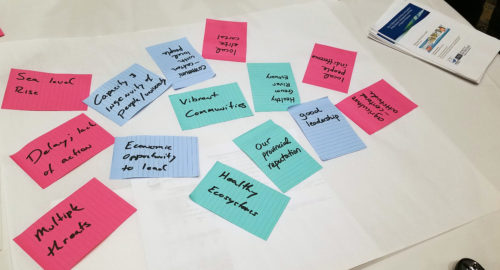
5. Evaluation and accountability are key throughout the process. Evaluation should not be viewed as an end-of-process activity, it should be a continuous process. Soliciting feedback through participant surveys and dialogue is just one part of the bigger picture. As mentioned previously, the goal of Collaborative Learning is improvement in a situation, thus participants generate action strategies that they think can improve the situation and take ownership of actions that they have the power to implement. The same is true in developing report cards. It is important to keep in mind that the goal is not just to create the report card product, but to improve the system we are working on. The kind of desired improvement might vary from system to system, but still, a theory of change and/or a larger evaluation framework is very much-needed. This is also something that I will be addressing in my research.
6. The Collaborative learning framework can be used by boundary spanning organizations, as the "change agents", to overcome the challenges of change. Dr. Feurt, using the Diffusion of Innovation Theory, concluded the workshop by stating that this is how Collaborative Learning works in the real world. I was pleasantly surprised, because coincidentally, this is also something that I proposed in my comprehensive exams last year. I wrote that Roger’s (1995) Diffusion of Innovation Theory, one of the most widely used social science theories that have been adapted in various disciplines, is probably the best theory that can be applied to Ecosystem Health Report Cards. We can apply this theory in two ways, first, in the adoption of the use Ecosystem health report card as a management and communication tool, and second, as an agent of behavior change. I also proposed that following this theory, the Integration and Application Network can be considered as the “change agent” and we can use this theory as a framework to improve our report card process. Also, IAN is widely considered as a boundary spanning organization, which is the new kind of specialist that is now needed.

Collaborative Learning as taught by Dr. Chris Feurt is made up of four phases – Assessment, Designing the process, Implementation, and Evaluation. But because the CERF workshop was only half-day, she was not able to give details on each of these phases. Dr. Feurt was kind enough to give me a hard copy of her Collaborative Learning Guide for Ecosystem Management, which I find extremely valuable. Interestingly, Dr. Feurt credits Dr. Michael Paolisso of the University of Maryland College Park as the person who had introduced Collaborative Learning to her and had influenced her to use Social Science methods in Natural Resource Management. The same goes for me. Dr. Paolisso is one of my dissertation committee members who really made me think on how to improve report cards so that it truly represents all stakeholders. Although there’s still some of aspect of the workshop that I have not covered in this blog, suffice to say, I believe that IAN’s report card development process can benefit from the Collaborative Learning framework. I am looking forward to having a wider discussion on how this can be implemented.
References:
Feurt, C. 2008. Collaborative Learning for Ecosystem Management. Wells National Estuarine Research Reserve, Wells Maine
Feurt, C. 2017. How Collaborative Learning can be used to bridge science, management and policy to improve outcomes. Participant workbook for half day training CERF Conference, Nov 5, 2017, Providence RI. Wells National Estuarine Research Reserve, Wells Maine, 8 p.
Citations:
- Daniels, Steven E., and Gregg B. Walker. 2001 Working Through Environmental Conflict: The Collaborative Learning Approach. Westerport, CT: Praeger. 328 pp.
- Kempton et al 1995
- Rogers, EM. 1995. Diffusion of Innovations. New York: Free Press.
About the author
Vanessa Vargas-Nguyen
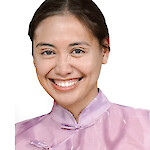
Dr. Vanessa Vargas-Nguyen is a Science Integrator with the Integration and Application Network and an associate faculty of the Marine Estuarine and Environmental Science Graduate Program. Her current interest is in transdisciplinary approaches, socio-environmental assessments, socio-environmental justice, stakeholder engagement, and adaptive environmental governance. Vanessa is originally from the Philippines and has extensive experience in molecular biology and marine science, specializing in microbial communities and molecular processes associated with Harmful Algal Blooms and shrimp, corals, and human diseases. She has since shifted her focus on how science can benefit society and was conferred with the first Ph.D. under the new Environment and Society foundation of the MEES graduate program. Her dissertation used ethnographic approaches to investigate the role of socio-environmental report cards in transdisciplinary collaboration and adaptive governance for a sustainable future. She received academic training from the University of the Philippines (BSc; MSc) and the University of Maryland (MSc; PhD). She is involved in developing holistic socio-environmental assessments for complex systems such as the Mississippi River and Chesapeake Bay watersheds and is coordinating a multi-year international transdisciplinary research consortium involving the US, Norway, Philippines, Japan, and India.

